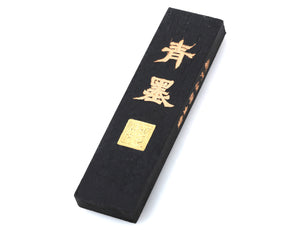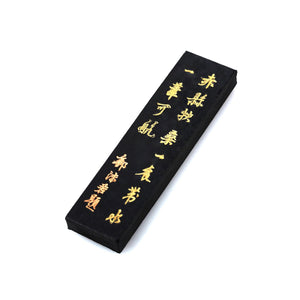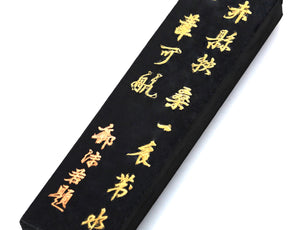Your Cart is Empty



ISK015
Traditionally used quality ink-stick famous for its black color with a shade of green and blue. Suitable for calligraphy writing, Sumi-e and Fineline Painting.
This stick is is widely used in China due to the ink it produces having a very distinct color which is unusual compared to other ink sticks which are often used. Another characteristic of the ink produced by this stick is the fact that due to the stick being pine-soot based, the ink is of a matte-black nature making it ideal for guest elements on a Chinese painting.
NOTE on shipment for this product:
For this product, the shipment price is already included in the product price. Shipping time is 8-18 working days. There is only one delivery option available for this product and it will be shipped separately from other products in your cart. For more information, please read our shipping section for liquid shipments in the FAQ.
Traditional Chinese Chinese Qing Mo Sumi & Calligraphy Ink Stick
Dimension: 1.2 in x 4.6 in x 0.4 in / 3.0 cm x 11.5 cm x 1.0 cm
Decorative elements: Golden decorative Chinese character print of the name of this product
Usage: for Asian brush painting and calligraphy writing
Material: Pine Soot
Colors: Black with shades of dark green and blue
More information: Weight: 2.1 oz / 60 g, 3.5 oz / 100g
The Qing Mo is an ink stick that is great for many types of artwork, including calligraphy writing and Sumi-e and Fineline painting. The stick is made from pine soot, which is the result of burning pine wood. As opposed to the glossy inks produced by ink sticks made of oil soot, pine soot produces a matte black finish. Traditionally, these inks are used as subjects that are the "guests" in paintings.
The main subjects in most paintings will be painted in glossy ink so they stand out in the artwork. Secondary subjects will be painted in ink with a matte finish, so they do not draw attention away from the main focal point of the work. Thusly, these subjects are commonly called guests.
Since the time of the Southern and Northern Dynasties (420-589 A.D.), the term Four Treasures of the Study has been used to describe the four tools that are considered essential for every Chinese artist. The tools are brushes, paper, ink slabs and ink sticks.
Since at least 2,000 years ago, well before liquid ink began to be used in Chinese art in the mid-1800s, artists have ground ink sticks on ink slabs. The powder produced by this act is then mixed with water to produce the ink to be used on the artwork. Even today, artists love this method because of the control it lends them over the consistency of the ink and the amount of water added determines how thick the mixture will be.
Throughout the storied history of ink sticks, these materials have come to be made into artworks themselves, coming in different shapes and sizes and with intricate carvings.
Collections: All Products, Ink Products, Ink Sticks & Watercolors